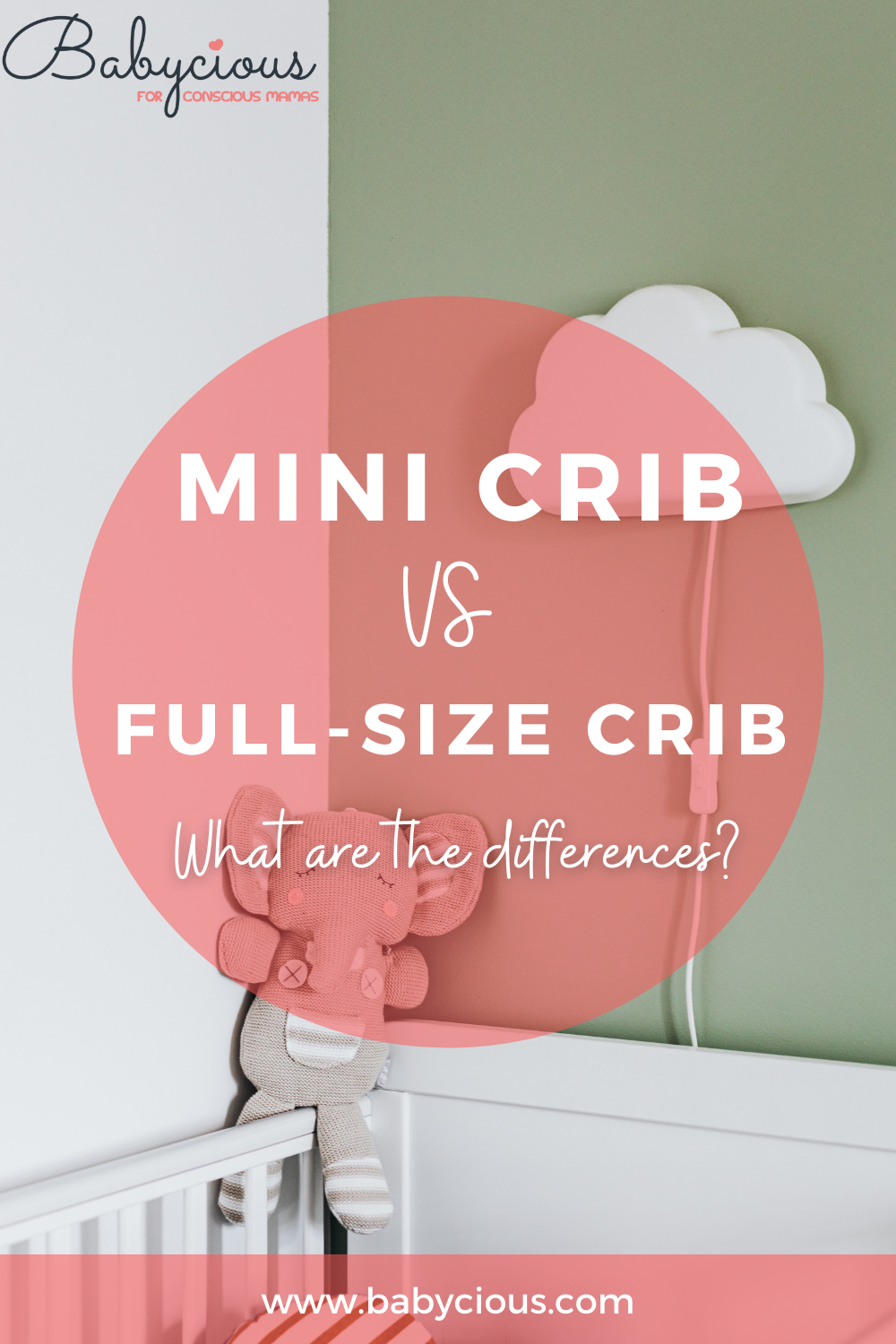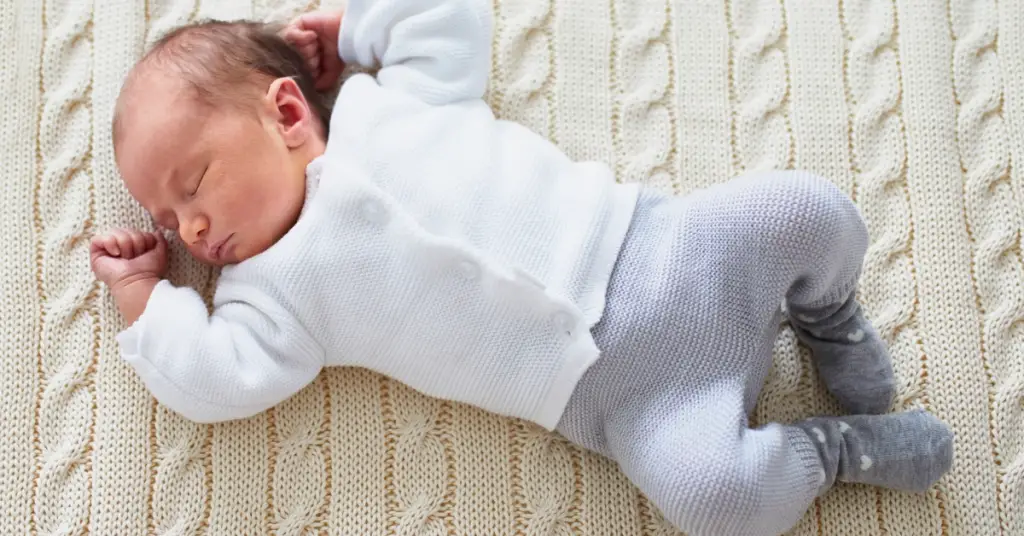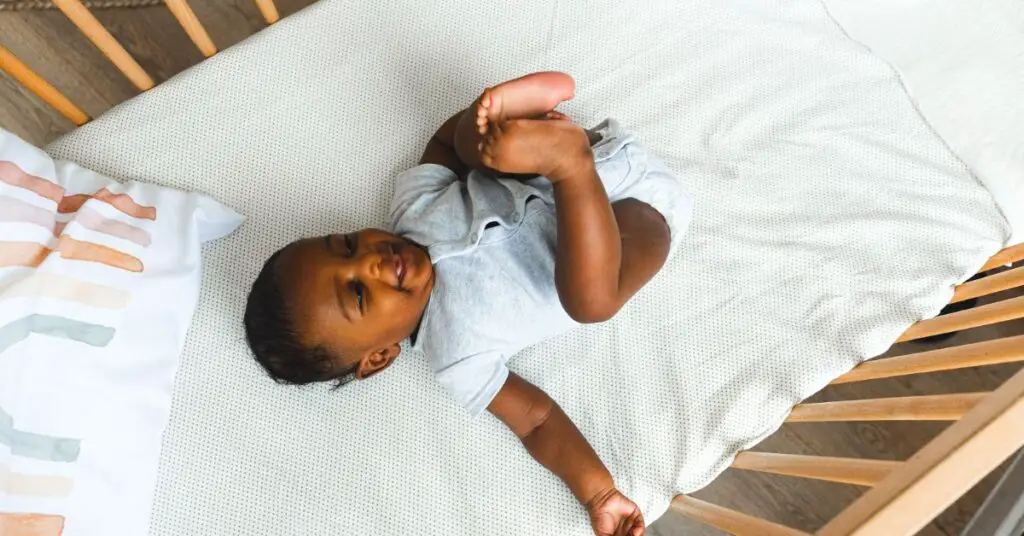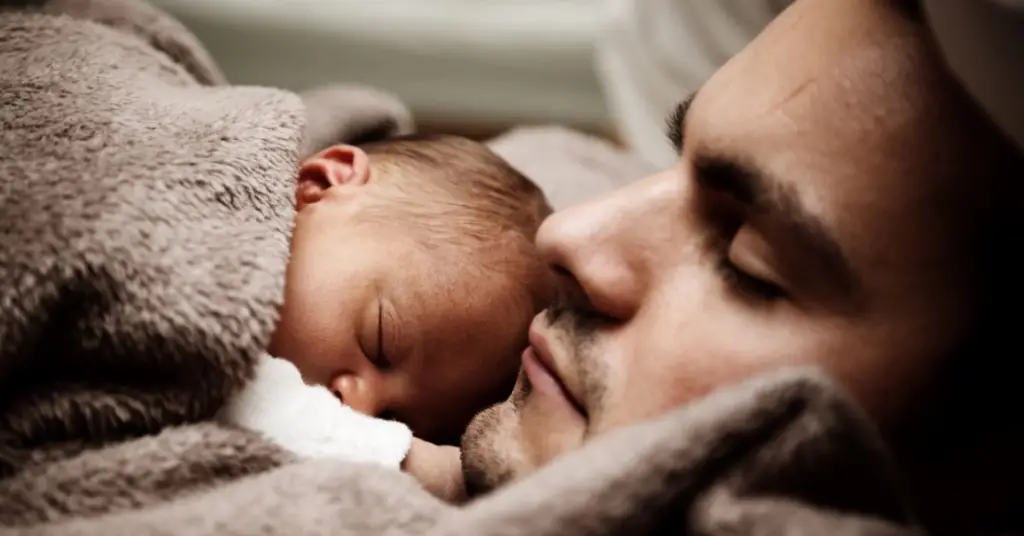Wondering what the difference between mini cribs and regular cribs is? Here’s a comprehensive guide to help you decide which type of crib is best for your needs.
The products mentioned on this page were independently selected by Babycious editors. As an Amazon Associate, Babycious may earn a commission from qualifying purchases.
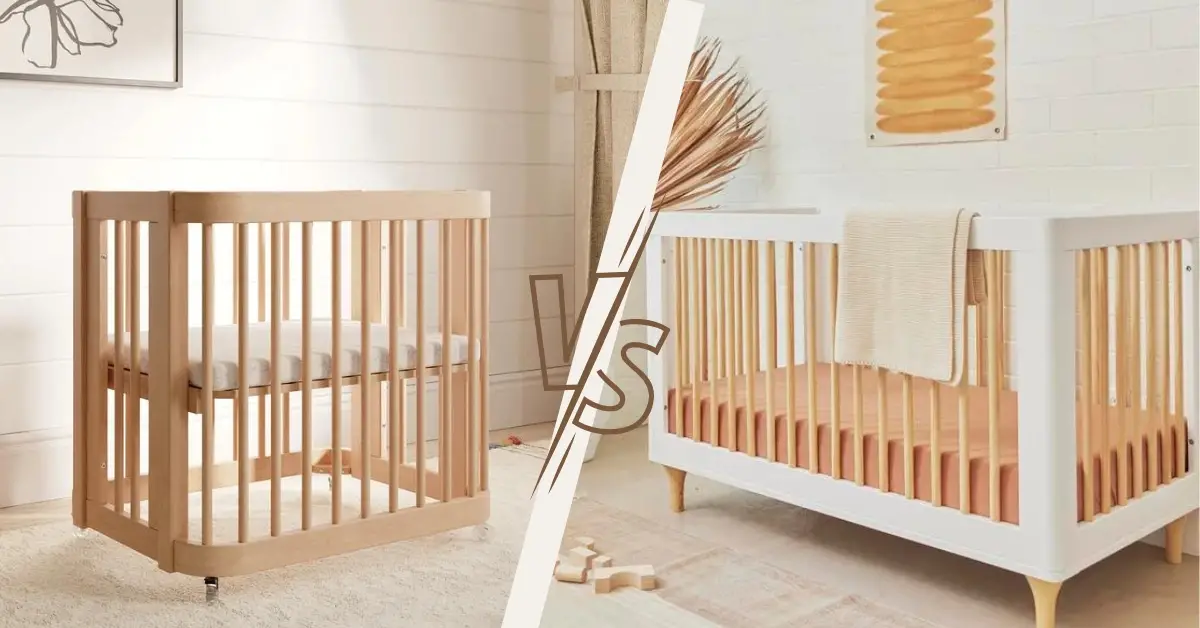
When it comes to cribs, there are two main types new parents will face: mini cribs and full-size cribs. Though they may seem the same at first, there are several key differences between these two types of cribs, mainly related to size. So, what are those differences? And which crib is right for you?
In this article, we give you the full disclosure on mini cribs and regular cribs, answering all your questions on the differences between them to help you decide which one is best for your needs.
What Is a Mini Crib?
First of all, a mini crib is a smaller version of the regular or standard crib.
The size of the average mini crib is 24 inches wide and 38 inches long, while the size of regular sized-crib is 28 inches wide and 52 inches long. The railings are generally as high on mini cribs as on full-size cribs, so mini cribs are just as safe, just smaller.
Mini cribs don’t abide by the standardized measurements of a standard classic crib. That’s why you will find mini cribs of different sizes. They are usually made of wood, but some mini cribs are made from other materials such as metal or plastic or a combination of hardwood and metal parts.
What Is a Mini Crib For?
A mini crib is a great option to consider if you want to make the most out of your small space. Whether you’re working with a small nursery or if you plan on sharing the same room with your baby, mini cribs are real space savers!
For a Small Nursery
When you have a small nursery where the dresser is already taking up most of the space, mini cribs are perfect because they take up less space than a regular-sized crib. Plus, mini cribs come in various colors and styles, so you can still have some fun when decorating your nursery.
For Shared Rooms
If you plan on sharing the same room with your baby, mini cribs are great options for you! They are much smaller than regular cribs, so they don’t take up as much space in the room. Plus, mini cribs usually come with a mattress that can be adjusted, so you can keep your baby close to you at night.
For Multiples
If you have twins or multiple children, mini cribs can be a great option for you because they take up less space than regular-sized cribs. You might be able to fit two mini cribs in the same space as one regular-sized crib.
Read Also: Best Double Bassinet for Twins – Top Picks for 2024
For the Grandparent’s House
If you want to get your baby a place to sleep at a grandparent’s or an auntie’s house, mini cribs are a great option. They are compact and easy to transport, so your baby can have a dedicated place to sleep whenever you’re visiting family, and they wouldn’t complain about it taking up much space, especially if you get them a cute mini crib!
When your baby is not there, they can even fold the mini crib flat and store it away until your next visit. So consider getting a foldable mini-crib if that’s what you intend to use it for.
A mini crib is sometimes referred to as a portable or compact mini crib. It can be moved around easily, especially since many models come with wheels for easy transport. Some will even fold flat for easy storage, and some can convert into a mini day bed or a twin-size bed to grow with your child. By the end of this article, you’ll find that mini cribs have so much to offer.
Pros and Cons of Mini Cribs
A mini crib has more advantages than it does disadvantages. So, if you decide to get one, you’ll have little to worry about, as mini cribs are generally safe and comfortable for your baby. Plus, mini cribs can be so much fun because they come in different colors and designs that will help make the nursery look even cuter!
One disadvantage mini-cribs may have is that they don’t last as long as full-size cribs. We find that mini cribs are (generally) less sturdy than full-size cribs. The quality of the build can be quite flimsy on some models making the mini cribs not as durable.
Also, you may find it hard to get a mini crib mattress and fitted sheets that fit your mini crib correctly, especially if you decide to go with a mini crib with custom dimensions!
Pros and Cons of Full-Size Cribs
A full-size crib is a cornerstone for any nursery. It is a piece of furniture that will last you until your child is done with crib sleeping and their siblings (and cousins) too. A full-size crib can also be used as a toddler bed and even for some young children, making it a great value in the long run.
But, because they are larger, they tend to have more moving parts and may be harder to assemble and dismantle than mini-cribs. And you might get stuck with an imposing piece of furniture once your baby is done with it. Luckily some cribs are actually convertible and can be reused to grow with your family like the dream on me 5 in 1 brody crib. You can read our full review of this popular crib here.
How Long Will a Mini Crib Last?
A mini crib will last for as long as your baby fits in it. That is until your baby gets too big for the mini crib, so you will have to transition them into a toddler bed.
Let’s do some math to find out how long exactly a mini-crib is going to last.
If you have an average mini crib that makes 38 inches in length and has a maximum weight capacity of 45 pounds, we’ll have to see when your baby would reach that same length and weight.
According to the growth charts developed by the Centers for Disease Control and Prevention (CDC), both female and male babies are expected to reach the length of 38 inches during their third year and still weigh less than 45 pounds by their fourth birthday.
So, if you want a good estimation of how long your average mini-crib will last, we can confidently say that most babies will outgrow their mini-crib by the age of two to three years old. We recommend, though, that you transition your baby out of the mini crib before their second birthday for more comfortable sleep.
That’s not bad if you compare it to when you would have to transition your baby from a regular-sized crib to a toddler bed, which is usually between the age of 18 months and 3 years.
Mini Crib vs Crib: Dimensions
Differences in dimensions are the main reason most parents are confused when having to choose between getting a mini crib and a regular-sized crib.
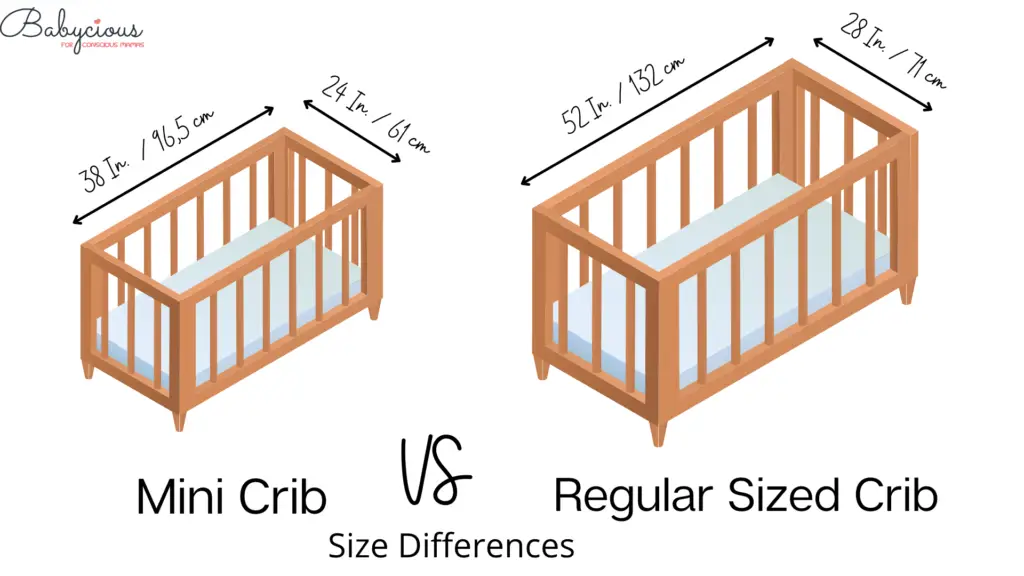
Let’s look first at the measurements of a mini crib:
Mini Crib Dimensions
The average length of a mini crib is 38 inches or 96,52 cm, and its average width is 24 inches or 60,96 cm.
Although these measurements are true for most mini cribs on the market, some mini cribs come in slightly different dimensions.
To give you a more clear answer on what a mini crib can measure, we compared the measurements of a sample of 10 popular mini cribs, and we found the following:
- The smallest mini crib length-wise measured 38 inches or 96,52 cm in length, which is the most common length found in mini cribs, while the biggest mini crib length-wise measured 44 inches or 111,76 cm.
- The smallest mini crib width-wise measured 23 inches or 58,42 cm, and the biggest mini crib width-wise measured 30 inches or 76,2 cm.
As you can see, mini cribs are quite versatile. Depending on your space and your needs, you’ll be sure to find a mini crib whose measurements are perfect for you.
Now, let’s compare these mini crib dimensions to the measurements of a regular-sized crib.
Full-Size Crib Dimensions
Answering what a full-size or regular-sized crib measures is a lot simpler since regular cribs have standardized measurements.
Regulations set by the Consumer Products Safety Commission (CPSC) require full-size cribs to have inner dimensions of 28 ± 5⁄8 inches (71 ± 1.6 centimeters) in width and 52 3⁄8 ± 5⁄8 inches (133 ± 1.6 centimeters) in length.
Simply put, the average length of a regular-sized crib is 52 inches or 132,08 cm, and its average width is 28 inches or 71,12 cm.
Mini Crib vs Regular Crib: Weight Limit
Both mini cribs and regular-sized cribs have weight limits, but the weight limit of a mini crib is usually less than that of a regular-sized crib.
Weight Limit of A Mini Crib
The average mini crib can accommodate a child who weighs up to 45 pounds or 20,41 kg as the weight limit of mini cribs varies from one mini crib to another.
Most babies don’t reach the weight of 45 pounds before turning 4 years old. And statistically, they would have moved from the crib way before they turn 4, so the weight limit should not be a constraint if you are thinking of getting a mini crib.
Weight Limit of A Full-Size Crib
The weight limit of a regular-sized crib is also variable depending on the sturdiness and build of each crib model, but most regular-sized cribs can accommodate a child who weighs up to 50 pounds or 22,68 kg. That’s plenty of weight for your baby to grow into.
Mini Crib vs Regular Crib: Mattress Size
The other big difference between mini cribs and regular-sized cribs is the size of their mattresses.
Mini Crib Mattress Size
As mini cribs are smaller than regular-sized cribs, mini crib mattresses are also smaller. The average mini crib mattress measures 38 inches by 24 inches or 96,52 cm by 60,96 cm.
A good mini crib mattress can be a bit tricky to find since mini cribs come in different shapes and sizes. Mini cribs usually come with a mattress, but you may find it useful to have a mini crib mattress that’s more comfortable for your baby than the mattress that came with the mini crib.
Keep in mind that what goes for the mattress also goes for the fitted sheets. Since mini crib mattresses are smaller than regular-sized cribs, mini crib fitted sheets could be harder to find, especially if you go with smaller or bigger than average dimensions for your mini crib.
Regular Crib Mattress Size
The good thing about a full-size mattress is that everything about it is standard, including the mattress. So you will have no trouble finding a crib mattress that fits your full-sized crib and that your baby sleeps comfortably on. Full-size crib sheets are also widely available, choose ones that fit snuggly on your mattress for safety, and don’t forget to change them regularly to preserve your baby’s comfort and health.
The average full-size crib mattress measures 52 inches by 28 inches or 132,08 cm by 71,12 cm.
Mini Crib vs Regular Crib: Price
Price is the final difference we’ll be looking at between mini cribs and regular-sized cribs.
Although you can find mini cribs, which are more expensive than regular-sized cribs, on average mini cribs are cheaper. This is likely because mini cribs do not necessarily have all of the features that a regular-sized crib has, so manufacturers can keep the price lower and still make a profit.
Bottom Line
Mini cribs and full-size cribs share many features and are equally comfortable and safe places for your baby to sleep in. We recommend a mini crib for families who live in smaller spaces, but mini cribs are also great for parents who are looking for a crib that is portable, compact, and overall versatile.
We hope that this article has helped you clear any confusion you might have had about mini cribs. If you have made up your mind about what you’re getting for your little one, tell us in the comments down below. Also, reach out to us with any questions you still have about mini cribs. We’ll be happy to answer them.
The purpose of this article is informative and educational only. It’s not a substitute for medical consultation or medical care. We do not accept any responsibility for any liability, loss, or risk, personal or otherwise, incurred as a consequence, directly or indirectly, from any information or advice contained here. Babycious may earn compensation from affiliate links in this content.
